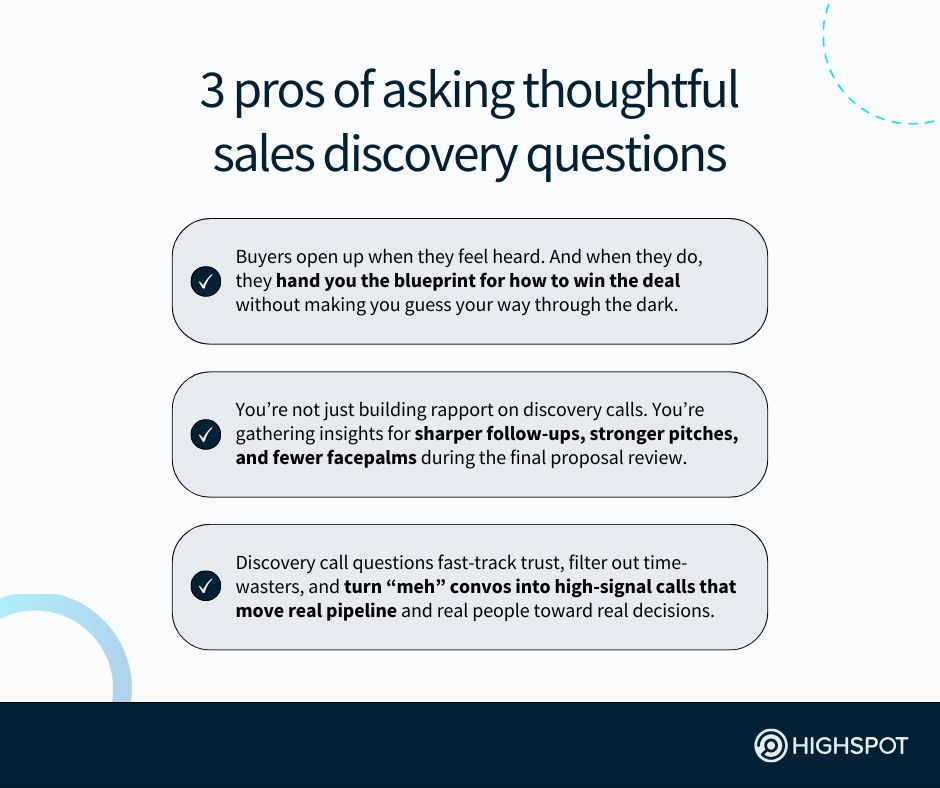Key Takeaways
- Great discovery calls aren’t interrogations. Rather, they’re insight factories. Reps who ask intentional, open-ended questions uncover real problems and build trust that moves deals forward with confidence.
- Modern sales discovery is more account connecting than qualifying. Top-performing reps prep with research, listen with intent, and use smart questions to show up informed, relevant, and ready to help buyers.
- Not every lead’s a good fit for your products or services—and that’s okay. Strong disqualifying questions save time, protect pipeline focus, and ensure reps prioritize the right deals with the right urgency.
Discovery call questions make or break a deal. As a sales rep, this is your chance to build a relationship with a buyer and make a good first impression.
If your buyer has already expressed interest in your offerings, you may think that all you have to do is identify if they’re a good fit … right? Not exactly.
The majority of prospects will not convert. That means you must ensure that every single conversation you have with a potential customer is meaningful, structured, productive, and—ultimately—moves the lead in question down your B2B sales funnel.
More specifically, it requires asking the right sales discovery questions that not only qualify prospects but also ensure your products and services can actually solve their pain points and problems in a way that meets their specific requirements.

What are sales discovery questions?
Sales discovery questions are a foundational tactic for how sales reps such as yourself uncover buyer context, identify pain points, and qualify opportunities with precision. These questions are used on discovery calls with buyers to surface goals, blockers, and intent signals you can use to tailor your follow-up.
Discovery call questions are especially useful for sales reps who need to quickly determine where a particular, recently qualified lead stands in their respective B2B buying journey without making the conversation feel like an interrogation.
The best discovery questions don’t just inform you on where prospects reside in their decision-making process. They also engage these individuals in a meaningful exchange, helping you assess whether a solution is worth pursuing together.
Thoughtful, probing questions also help you gauge the strength of the opportunity and decide whether to advance a lead in your sales pipeline or archive them in your customer relationship management system as “Poor fit” or “Not ready”.
Asking these questions is a critical step in your sales discovery process and the difference between pursuing potential customers with a high likelihood of converting into new business or wasting time on mismatched opportunities.
Why are discovery calls important for reps?
Asking a list of standardized questions helps you uncover deal-shaping insight and position yourself and your organization at large as strategic partners.
Too many B2B sellers burn precious time on initial calls asking vague or surface-level questions. To ensure your discovery is sharp and tactical, ask questions that expose urgency, map buying dynamics, and earn access to power (key stakeholders and decision-makers you can speak with later in the deal cycle).
| Common sales discovery mistake | How it negatively impacts deals |
|---|---|
| Asking only surface-level questions about features and functionality | Deals get stuck when conversations don’t go deep enough to surface the prospect’s real issues, business needs, and internal decision dynamics. |
| Jumping to pitch mode before uncovering the prospect’s real pain or top priority | Pitching too soon makes you sound like every other rep and risks missing the chance to uncover valuable insights that drive urgency and alignment. |
| Failing to ask leads about their defined budget or decision timelines early enough | If you don’t ID budget constraints or decision-making timeline early, your sales team risks misalignment and slows down the entire discovery process. |
| Not exploring cross-functional impact with other departments or stakeholder teams | Skipping this question leaves out all key buying committee members and prevents momentum from building across those decision-makers. |
| Ignoring high-intent buying signals or objections raised during discovery calls | When pushback goes unaddressed, trust erodes, the value prop weakens, and you lose credibility in each sales conversation with that potential client. |
How discovery call questions help you identify worthwhile sales opportunities
“Trust is often the deciding factor in whether a buyer moves forward with a purchase or partnership,” Forbes Councils Member Ray Makela recently wrote. “In the early stages of engagement, buyers are assessing not just your solution, but also your credibility, transparency and ability to understand their needs.”
And asking carefully crafted discovery call questions enables you and others on your sales team to—well—discover a prospect’s biggest challenges and plant the seeds for a strong relationship with them that leads to revenue growth for your business and a competitive advantage for your eventual customer.
Get in-depth insights into a given prospect’s goals
Successful sales discovery requires reps like you to go beyond the basics and dig into the big-picture strategic goals your engaged buyer is measured against.
If you’re not asking questions that tie to outcomes, you’re not gathering insight that can shape a compelling sales motion. When you’re able to align your solution with their goals, you’re not just selling—you’re helping them win.
Great discovery calls are ones in which the conversation feels less like an overt sales pitch and more like a planning session about the prospect’s vision for the next six to 12 months (or longer) so they make a sound buying decision.
Unearth the pain points a lead wants to address
If you’re not uncovering pain, you’re not uncovering value. Plain and simple.
Great sales professionals craft questions that prompt prospects to share granular, specific details about what isn’t working in their current solution or process.
When you express genuine interest in the prospect’s situation, you create space for honesty and vulnerability, which opens the door to trust.
The more they talk about their unique business challenges, the easier it becomes to position the key benefits of your offerings as a way to solve the problem they’re facing and advance them further in their purchasing process.
Leverage active listening for follow-up questions
Too many reps miss golden opportunities because they aren’t really paying close attention to the prospect’s pain points and needs. Instead, they’re waiting to talk.
Active listening helps you keep the prospect talking about what matters most to them and ensures the conversation doesn’t go off track.
Follow-ups that flow naturally are more likely to surface specific details regarding a B2B buyer’s challenges and give you leverage for closing deals later.
When you’re fully present and asking clarifying questions based on what you just heard (and using AI-powered conversation intelligence to get just-in-time guidance on discovery calls), you’re showing leads that you’re on the same page.
Types of sales discovery questions
Conducting discovery calls is certainly part art, part science.
That said, there is a proven framework that practically all B2B sales leaders implement for their teams today that helps them ask the right questions about prospects’ business needs.
Some of the most popular kinds of sales discovery call questions include:
Open-ended questions
These are your “Let’s get them talking” lifeline. No ‘yes or no’ snoozefests here, just golden gates to buyer brain dumps. These discovery questions create space, spark energy, and turn stiff calls into captivating discussions with real stakes.
Let leads talk (and, at times, even steer the conversation a bit), and chances are they’ll tell you everything you need to help them win. This ‘all-ears’ approach is how you can efficiently advance them to the next stage of the buying process.
Priority-alignment questions
These questions zero in on what’s truly important, not what’s nice, fluffy, or buried in the backlog. They surface what’s urgent with leads, who owns various decision-making processes, and what’s at risk if they don’t achieve a given goal or change their current process or approach to addressing a major issue.
Nail this, and, suddenly, you’re not just another vendor. You’re their secret weapon.
Process-clarifying questions
Think of these as your internal GPS. These sales discovery call questions help you decode how things actually get done, not how people wish they got done.
From procurement potholes to approval U-turns, the Qs guide you through the messy middle. Ask the right ones, and watch roadblocks light up like a runway.
Stakeholder-mapping questions
Who’s whispering in buyers’ ears? Who signs? Who stalls? Which executive stakeholders must be looped in ASAP? These questions pull the curtain back on the power dynamics that make or break momentum. No more flying blind.
Ask with confidence, and you’ll know who to charm, chase, or convert into a champion.
Fit-check questions
Protecting your time, energy, and sanity is essential. By asking these questions on discovery calls, you instantly reveal whether the juice is worth the squeeze.
If the vibes are off (or, at the very least, you can’t easily discern a lead’s BANT), bail early and pivot your focus to another prospect ready for real change.
| Expert discovery call tip | How it helps sales reps |
|---|---|
| Let the buyer talk (much) more than you | Buyers reveal gold, when you stop filling every silence with mindless chatter. You hear raw, unfiltered priorities, frustrations, and decision signals that rarely show up when you’re doing all the talking. |
| Repeat what you heard before responding | Prove you’re tuned in, not just taking notes. Echoing key points back makes leads feel seen and heard, which drives deeper engagement. You build credibility simply by reflecting their reality better than they can. |
| Ask leads one layered question at a time | Keep the focus tight and make buyers dig in with real clarity. A well-structured question pulls more clarity than a multi-part mess. It lets buyers breathe, think, and give honest, nuanced answers you can actually use. |
| Confirm timelines before pitching solutions | Help set the pace and avoid ‘outrunning’ the buyer. You’ll pitch smarter, sequence better, and build a smarter follow-up rhythm. Bonus: You avoid the awkward moment when you’re ready to sell and they’re still evaluating. |
| Dig into the ‘why now’ without being pushy | Surface real urgency without triggering defensive energy. It shows you care about their timing, not just yours. Plus, urgency helps spotlight internal or external catalysts you can tie directly to your solution. |
| Use silence after asking a tough question | Give prospects space to open up instead of dodging the hard stuff. That pause? It’s where gold lives. In that moment of discomfort, you get truth, honesty, and signals that help shape smarter next steps. |
| Write down exact lead phrases to use later | Mirror their language to make your follow-up land 10x stronger. You sound like them, not a seller, which builds trust and rapport faster. It also shows you’re not just listening—you’re investing in their language and logic. |
20 specific sales discovery questions to ask on your first call with buyers
On to the main event. No modern sales strategy can succeed with reps doing the upfront dirty work: asking these sales discovery questions right off the bat.
1. What are your top goals this quarter, and who’s accountable for delivering them?
- Key benefit of discovery questions like this: Uncovers near-term priorities fast
The goal here is to see where the business is focused right now and which leaders are feeling the most pressure to execute. Big goals usually come with tight timelines and big expectations, so use that urgency to guide the rest of the call. You’ll find out who cares, who decides, and who needs help hitting their number.
2. Where are you currently at in your evaluation or vendor exploration process?
- Key benefit of discovery questions like this: Identifies evaluation stage
Pinpointing where a prospect is in their evaluation helps tailor your sales messaging to match their mindset. If they’re early, educate. If they’re deep in comparisons, differentiate fast. Either way, you now know what kind of ride you’re in for.
3. What would happen if you stuck with the status quo with existing solutions?
- Key benefit of discovery questions like this: Reveals urgency to change
The goal here is to create contrast between inaction and progress, helping the buyer articulate risks and costs of doing nothing. People move when staying put becomes scarier than switching vendors. So, push that status quo into the spotlight and let them see its cracks to entice a rip-and-replace sooner than later.
4. What is your target, desired outcome, as it relates to getting a new solution?
- Key benefit of discovery questions like this: Defines outcome expectations
This gives you a clear picture of what a successful business outcome looks like from their point of view. It’s less about features and functionality and more about feelings: confidence, clarity, and control. Now, you know what you’re really selling.
5. How would your team define success after onboarding a solution such as ours?
- Key benefit of discovery questions like this: Frames solution impact
You’re inviting the buyer to paint a picture of the post-implementation dream state and ROI they ideally realize. Let them describe the win, because when they say it, they own it. That vision becomes your shared North Star on future sales calls.
6. Can you share relevant insights into what prompted you to explore options now?
- Key benefit of discovery questions like this: Explores buying trigger
Here, you want to recognize where a given lead is coming from and why they’re searching the market today. Did the wheels fall off with their current solution? Or are they just window shopping? Either way, knowing the backstory lets you steer with context and pivot your approach as the conversation gradually unfolds.
7. How would this solution impact day-to-day operations or customer experience?
- Key benefit of discovery questions like this: Connects to tangible benefits
Get specific about what will actually improve once you and your company are in the picture—revenue, time, experience, efficiency. That’s where compelling value shows up. Ask it right, and they’ll start building your business case for you.
8. What are the top 2–3 pain points that your department is running into right now?
- Key benefit of discovery questions like this: Spotlights real-time friction
This is the path into the prospect’s distinct challenges and persistent (and palpable) frustrations. If they open up here, you’re cooking with gas. Listen carefully, though. You’re hearing the problem they want to pay someone to fix.
9. How would you describe the current internal process for solving this challenge?
- Key benefit of discovery questions like this: Surfaces internal blockers
Get under the hood of how they’re trying to solve the problem today. There’s gold in the gaps. Find the friction, and you’ve found your foot in the door.
10. What does the ‘best’ solution look like for your business from your perspective?
- Key benefit of discovery questions like this: Aligns with buying criteria
This question anchors your value proposition to their vision of success. Let them tell you what good looks like, then become it. You’re not presenting an outright sales pitch here. Rather, you’re reflecting on an ideal-state scenario with leads.
11. What are key milestones in your timeline regarding the decision-making process?
- Key benefit of discovery questions like this: Maps out sales process path
Understanding a buyer’s preferred (or set-in-stone) timeline means you can align your efforts and avoid misfires. Don’t be the seller who asks for a close in Q2, when the decision’s not until Q4. Get the mutual action plan in place, and ‘follow the map.’
12. How would a solution like this affect cross-functional teams beyond your team?
- Key benefit of discovery questions like this: Uncovers broader business impact
Sales conversations don’t stay in silos. (Or, at least they shouldn’t). If you’re going to land a deal, you’ll need to know how it hits C-suite, IT, procurement, and other departmental leaders. Bigger impact, bigger buy-in. Consider creating a digital sales room that enables all stakeholders to access deal materials and info.
13. What are must-haves versus nice-to-haves when evaluating potential vendors?
- Key benefit of discovery questions like this: Prioritizes purchase drivers
Everyone’s got a wishlist, but not everything makes the cut. Get clear on what matters to account decision-makers most so you don’t waste time selling features they don’t need. Hit the must-haves hard, and let the rest be bonus points.
14. What are the top risks or concerns you’re hoping to avoid with a new solution?
- Key benefit of discovery questions like this: Surfaces deal blockers early
You’re proactively removing friction before it becomes a deal-killer. If they fear data loss, share your data and security policies and certifications. If it’s integration drama, bring up how your software directly syncs with other popular solutions a lead already uses. You can’t solve problems that you don’t talk about.
15. What is your current approach to measuring ROI in this area of the business?
- Key benefit of discovery questions like this: Anchors to performance metrics
The answer here shows how they quantify value and prove ROI. If it’s pipeline, close rates, or cost savings, that’s your new language. Speak it fluently, and you’ve got an ‘in’—as well as a way to show how they achieve their desired results.
16. How would you explain this initiative to someone in finance or procurement?
- Key benefit of discovery questions like this: Prepares stakeholder alignment
The budget-holders need a different story than your champion does. Let them write that story out loud with you now. Bonus: You can offer to share additional resources, content, sell sheets, collateral, assets in the digital sales room that specifically address any comments, concerns, or questions they bring up on discovery calls.
17. What are blockers or bottlenecks that typically slow decisions down internally?
- Key benefit of discovery questions like this: Flags internal deal hazards
There are ghosts in every machine. Find the pressing procurement problems plaguing your prospects early on in your sales prospecting. Maybe it’s a slow legal team, maybe it’s budget freeze roulette. Either way, better to know than guess.
18. What are the expectations for implementation and ramp time across teams?
- Key benefit of discovery questions like this: Sets demo success criteria
The best demos are custom-tailored, not templated. Let leads tell you what matters most to them, and build your product walkthrough accordingly. This kind of intentional sales engagement is the cornerstone of effective discovery today.
19. What are your priorities, when it comes to piloting or doing a product demo?
- Key benefit of discovery questions like this: Manages onboarding expectations
Don’t get caught promising a go-live in 30 days, if a given prospect requires 90 days to even get started using your product. Learn the lift, manage the story.
20. Can we book a call with your buying committee and our account executives?
- Key benefit of discovery questions like this: Advances multi-threading
You’re asking for the room where it happens: decision-makers, stakeholders, and other buying committee members. Make the ask clear, collaborative, and high-value. Then create a digital sales room and bring the right voices to the table.
Identifying the right leads for discovery calls using AI agents and analytics
Nailing your sales discovery process is vital.
But it becomes a lot harder to do when your go-to-market teams lack a single source of truth where they can easily access and analyze key data associated with rep outreach.
“Working in the dark is no easy task,” Highspot’s Fast-flowing Sales Pipeline eBook explains. “Without interest and intent data, delivering the relevant, personalized engagements that put discovery calls and demos on the calendar is an impossible one.
With a full picture of prospect behavior, however, the guide noted “you can lay out a data-backed plan of attack that doesn’t leave you firing wildly in the darkness.”
The full picture can be realized with a GTM platform at the center of your tech environment.
Specifically, one like Highspot with built-in AI that serves up valuable insights tied to discovery calls and a number of other sales tactics and buyer activities so all team members can make data-backed adjustments.
Your top priority is clear: It’s not enough to simply know which questions to ask prospective customers to progress them in the sales cycle and, in time, close more deals.
You also need a unified go-to-market enablement platform that shares insights your reps, marketers, and enablement personnel can use to evolve your approach.




